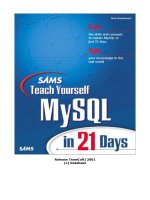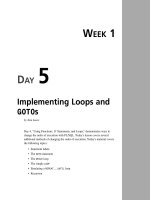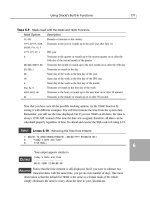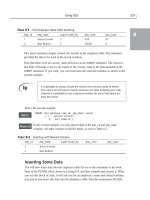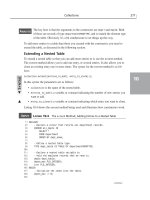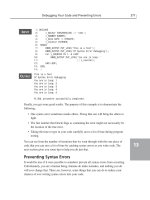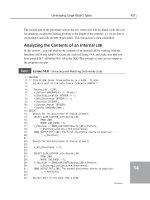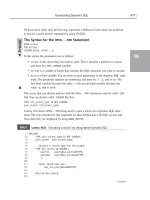Tài liệu Teach Yourself PL/SQL in 21 Days- P5 doc
Bạn đang xem bản rút gọn của tài liệu. Xem và tải ngay bản đầy đủ của tài liệu tại đây (2.42 MB, 50 trang )
Using Oracle’s Built-In Functions 177
6
T
ABLE
6.9
Masks Used with the
ROUND
and
TRUNC
Functions
Mask Options Description
CC
,
SCC
Rounds or truncates to the century
YYYY
,
SYYYY
,
YEAR
,Truncates to the year or rounds up to the next year after July 1st
SYEAR
,
YYY
,
YY
,
Y
IYYY
,
IYY
,
IY
,
I
ISO year
Q
Truncates to the quarter or rounds up to the nearest quarter on or after the
16th day of the second month of the quarter
MM
,
MON
,
MONTH
,
RM
Truncates the month or rounds up to the next month on or after the 16th day
DD
,
DDD
,
J
Truncates or rounds to the day
WW
Same day of the week as the first day of the year
IW
Same day of the week as the first day of the ISO year
W
Same day of the week as the first day of the month
Day
,
Dy
,
D
Truncates or rounds to the first day of the week
HH24
,
HH12
,
HH
Truncates to the hour or rounds up to the next hour on or after 30 minutes
MI
Truncates to the minute or rounds up on or after 30 seconds
Now that you have seen all the possible masking options, try the
TRUNC
function by
testing it with different examples. You will first truncate the time from the system date.
Remember, you still see the time displayed, but if you use
TRUNC
on all dates, the time is
always 12:00 AM. instead of the time the date was assigned; therefore, all dates can be
calculated properly regardless of time. Go ahead and execute the SQL code in Listing 6.19.
L
ISTING
6.19
Removing the Time from
SYSDATE
1: SELECT TO_CHAR(TRUNC(SYSDATE),’MM/DD/YYYY HH:MM:SS AM’)
2: “Today’s Date and Time”
3: from DUAL;
Your output appears similar to
Today’s Date and Time
-----------------------
06/21/1999 12:00:00 AM
Notice that the time element is still displayed, but if you were to subtract two
truncated dates with the same time, you get an even number of days. One more
observation is that the default for
TRUNC
is the same as a format mask of
DD
, which
simply eliminates the need to worry about the time in your calculations.
I
NPUT
O
UTPUT
A
NALYSIS
08 7982 ch06 11.8.00 11:23 AM Page 177
Please purchase PDF Split-Merge on www.verypdf.com to remove this watermark.
You can test the
TRUNC
function by truncating the
SYSDATE
to the nearest quarter by exe-
cuting the code in Listing 6.20.
L
ISTING
6.20
Truncating to the Quarter
1: SELECT TO_CHAR(TRUNC(SYSDATE,’Q’),’MM/DD/YYYY HH:MM:SS AM’)
2: “Today’s Date and Time”
3: from DUAL
Assuming today’s date is 06/01/99, you get the following output:
Today’s Date and Time
-----------------------
04/01/1999 12:00:00 AM
This result makes sense because June is in the second quarter, and the quarter
ranges from 04/01/99 to 06/30/99. Truncating to the quarter gives the beginning
date for the applicable quarter. You’ll get the opportunity to test this function in the
exercises at the end of the lesson.
The
ADD_MONTHS
Function
The
ADD_MONTHS
function adds or subtracts months from a date. Because this function is
overloaded, which means that you can pass different data types to the same function or
change the order of the parameters, you can specify the parameters in any order.
ADD_MONTHS(date_passed, months_to_add)
If
months_to_add
is positive, it adds months into the future. If the
months_to_add
number is negative, it subtracts months from
date_passed
. You can specify
months_to_add
as a fraction, but Oracle completely ignores the fraction. You can indi-
cate the day level by using other Oracle functions. Another caution is that Oracle returns
the same day in the resulting calculation except when the last day in one month (for
example, March 31st) and the resulting month does not have as many days. (For
example, April 30th is the answer to adding one month.) The following three examples in
Listing 6.21 provide the same result.
L
ISTING
6.21
Adding Two Months to
SYSDATE
1: SELECT ADD_MONTHS(SYSDATE,2) from DUAL;
2: SELECT ADD_MONTHS(SYSDATE,2.654) from DUAL;
178 Day 6
I
NPUT
S
YNTAX
A
NALYSIS
I
NPUT
O
UTPUT
08 7982 ch06 11.8.00 11:23 AM Page 178
Please purchase PDF Split-Merge on www.verypdf.com to remove this watermark.
Using Oracle’s Built-In Functions 179
6
All of these (assuming the date is 06/02/99) produce the following output:
ADD_MONTH
---------
02-AUG-99
You can see what happens for the last day of the month by adding one month to March
31st, as shown in Listing 6.22.
L
ISTING
6.22
Adding One Month
SELECT ADD_MONTHS(TO_DATE(‘31-MAR-99’),1) from DUAL;
This example has the output
ADD_MONTH
---------
30-APR-99
Oracle could not output April 31st because no such date exists.
The
NEXT_DAY
Function
The
NEXT_DAY
function returns the next date in the week for the day of the week speci-
fied after the input date. The time returned is the time specified by the input date when
called.
NEXT_DAY(input_date_passed, day_name)
The
NEXT_DAY
function offers a lot of possibilities. You can calculate anything
from the first Monday of every month to each payday in a calendar year. You’ll
start by testing the
NEXT_DAY
function on the
SYSDATE
function to find the next Monday.
Assume the
SYSDATE
is June 3, 1999. Your own results will differ when you execute the
code in Listing 6.23.
L
ISTING
6.23
Finding the First Monday After the Current Date and Time
1: SELECT TO_CHAR(NEXT_DAY(SYSDATE,’Monday’),’MM/DD/YYYY HH:MM:SS AM’)
2: “Next_Day”
3: from DUAL;
O
UTPUT
I
NPUT
O
UTPUT
S
YNTAX
A
NALYSIS
I
NPUT
08 7982 ch06 11.8.00 11:23 AM Page 179
Please purchase PDF Split-Merge on www.verypdf.com to remove this watermark.
The result returned for the
SYSDATE
of June 3, 1999 is
Next_Day
-----------------------
06/07/1999 07:06:38 AM
The first Monday after the date is June 7, 1999. Because you are using the
SYSDATE
,the corresponding time value is returned when the function is called.
You can find the first Monday for August 1999 by executing the code in Listing 6.24.
L
ISTING
6.24
Finding the First Monday in the Month of August
1: SELECT TO_CHAR(NEXT_DAY(‘01-AUG-99’,’Monday’),’MM/DD/YYYY HH:MM:SS AM’)
2: “Next_Day”
3: from DUAL;
Your output is
Next_Day
-----------------------
08/02/1999 12:00:00 AM
Although the first Monday in August is 08/02/99, is there a logic problem here?
If you repeat the example but use a month in which Monday is the first day of
the month, what happens? Execute the code in Listing 6.25.
L
ISTING
6.25
Finding the First Monday in the Month of September
1: SELECT TO_CHAR(NEXT_DAY(‘01-MAY-00’,’Monday’),’MM/DD/YYYY HH:MM:SS AM’)
2: “Next_Day”
3: from DUAL;
Your output is
Next_Day
-----------------------
05/08/2000 12:00:00 AM
The result is definitely not what you had in mind! The
NEXT_DAY
function returns
the next day of the day specified. If the day of the week specified matches the
input date, it adds one week to the input date. If you want to calculate the first occur-
rence of any day in the month, always use the end date of the previous month. Review
the proper code in Listing 6.26.
180 Day 6
O
UTPUT
A
NALYSIS
I
NPUT
O
UTPUT
A
NALYSIS
I
NPUT
O
UTPUT
A
NALYSIS
08 7982 ch06 11.8.00 11:23 AM Page 180
Please purchase PDF Split-Merge on www.verypdf.com to remove this watermark.
Using Oracle’s Built-In Functions 181
6
L
ISTING
6.26
The Proper Method to Find the First Monday in a Given
Month
1: SELECT TO_CHAR(NEXT_DAY(‘30-APR-00’,’Monday’),’MM/DD/YYYY HH:MM:SS AM’)
2: “Next_Day”
3: from DUAL;
Your output is
Next_Day
-----------------------
05/01/2000 12:00:00 AM
You finally have the proper logic for what you intended to find.
The
LAST_DAY
Function
The
LAST_DAY
function provides the last day of the given month. A useful purpose is to
determine how many days are left in the given month.
LAST_DAY(input_date_passed)
You will compute the last days in the month when summer officially starts from 1999.
Execute the code in Listing 6.27.
L
ISTING
6.27
Finding the Last Day of the Month Starting Summer
1: SELECT TO_CHAR(LAST_DAY(‘30-JUN-99’),’MM/DD/YYYY HH:MM:SS AM’) “Last_Day”
2: from DUAL;
Your output is
Last_Day
-----------------------
06/30/1999 12:06:00 AM
I purposefully used the last day of the month to illustrate an important fact.
Unlike
NEXT_DAY
, which adds one week if the day of the week specified is the
same as the input date, the
LAST_DAY
function always returns the last day of the month
even if the input date is the same.
You can take this one step further and see how many days of summer exist in the month
of June by subtracting the last day of the month by the start date of summer. Execute
Listing 6.28 to see the result.
I
NPUT
O
UTPUT
S
YNTAX
I
NPUT
O
UTPUT
A
NALYSIS
08 7982 ch06 11.8.00 11:23 AM Page 181
Please purchase PDF Split-Merge on www.verypdf.com to remove this watermark.
L
ISTING
6.28
Calculating the Number of Days of Summer in June
1: SELECT LAST_DAY(‘20-JUN-99’) “Last_Day”,
2: LAST_DAY(‘20-JUN-99’) - TO_DATE(‘20-JUN-99’) “Days_Summer”
3: from DUAL;
Your output is
Last_Day Days_Summer
---------------------
30-JUN-99 10
The
MONTHS_BETWEEN
Function
The
MONTHS_BETWEEN
function returns the number of months between two given dates. If
the day is the same in both months, you get an integer value returned. If the day is dif-
ferent, you get a fractional result based upon a 31-day month. If the second date is prior
to the first date, the result is negative.
MONTHS_BETWEEN(input_date1,input_date2)
You can see all the possible returned values by executing the code in Listing 6.29.
L
ISTING
6.29
Experimenting with
MONTHS_BETWEEN
1: SELECT MONTHS_BETWEEN(‘25-DEC-99’,’02-JUN-99’) “Fractional”,
2: MONTHS_BETWEEN(‘02-FEB-99’,’02-JUN-99’) “Integer”
3: from DUAL;
Your output is
Fractional Integer
---------- ---------
6.7419355 -4
182 Day 6
I
NPUT
O
UTPUT
S
YNTAX
I
NPUT
O
UTPUT
Who cares about seeing the fractional part of a 31-day month? To convert
the fraction to days, simply multiply the
TRUNC
value of the fractional part by
31. If you want to display the month, use
TRUNC
on this value.
Tip
08 7982 ch06 11.8.00 11:23 AM Page 182
Please purchase PDF Split-Merge on www.verypdf.com to remove this watermark.
Using Oracle’s Built-In Functions 183
6
The
NEW_TIME
Function
Have you ever wondered what time it is in Germany? Would your phone call wake up
your friend in the middle of the night? The
NEW_TIME
function enables you to find out the
time in the time zones listed in Table 6.10 by simply passing the date and time of the
first zone and specifying the second zone.
NEW_TIME(input_date_and_time, time_zone1, time_zone2)
See Table 6.10 for the valid time zones.
T
ABLE
6.10
Time Zones
Time Zone
Abbreviation Time Zone Description
AST
Atlantic Standard Time
ADT
Atlantic Daylight Savings Time
BST
Bering Standard Time
BDT
Bering Daylight Savings Time
CST
Central Standard Time
CDT
Central Daylight Savings Time
EST
Eastern Standard Time
EDT
Eastern Daylight Savings Time
GMT
Greenwich Mean Time (the date line!)
HST
Alaska-Hawaii Standard Time
HDT
Alaska-Hawaii Daylight Savings Time
MST
Mountain Standard Time
MDT
Mountain Daylight Savings Time
NST
Newfoundland Standard Time
PST
Pacific Standard Time
PDT
Pacific Daylight Savings Time
YST
Yukon Standard Time
YDT
Yukon Daylight Savings Time
You can compute the date and time difference between Chicago and Los Angeles by
specifying Central Daylight Time to Pacific Daylight Time. Enter and execute the code in
Listing 6.30.
S
YNTAX
08 7982 ch06 11.8.00 11:23 AM Page 183
Please purchase PDF Split-Merge on www.verypdf.com to remove this watermark.
L
ISTING
6.30
Time Change from Chicago to Los Angeles
1: SELECT TO_CHAR(NEW_TIME(TO_DATE(‘060299 01:00:00 AM’,
2: ‘MMDDYY HH:MI:SS AM’),
3: ‘CDT’,’PDT’), ‘DD-MON-YY HH:MI:SS AM’) “Central to Pacific”
4: from DUAL;
184 Day 6
I
NPUT
Remember, minutes are expressed as
MI
, not
MM
. This is a common mistake!
Tip
Your output is
Central to Pacific
-----------------------
01-JUN-99 11:00:00 PM
Because there is a two-hour time difference, you not only see the revised time,
but also the revised date. I guess you truly can go back in time!
O
UTPUT
In a database that traverses time zones, you might want to store the time
and date for all entries in one standardized time zone, along with the time
zone abbreviation from the original time zone. This arrangement saves you
a lot of time and coding when designing the database.
Tip
A
NALYSIS
The
ROUND
Function
ROUND
is similar to the
TRUNC
function. In fact, it uses the same format mask as
TRUNC
in
Table 6.9. This function enables you to round up or down based upon the format mask.
The default mask when specifying a
DATE
value is
DD
. Some useful purposes for this are
• Rounding to the nearest minute for billing cellular-based calls
• Rounding to closest month to determine a pay period
ROUND(input_date_and_time_or_number, rounding_specification)
You can practice rounding to the nearest minute to charge people who use cellular
phones by entering the code in Listing 6.31.
S
YNTAX
08 7982 ch06 11.8.00 11:24 AM Page 184
Please purchase PDF Split-Merge on www.verypdf.com to remove this watermark.
Using Oracle’s Built-In Functions 185
6
L
ISTING
6.31
Rounding to the Nearest Minute
1: SELECT TO_CHAR(ROUND(TO_DATE(‘060299 01:00:35 AM’,
2: ‘MMDDYY HH:MI:SS AM’),
3: ‘MI’), ‘DD-MON-YY HH:MI:SS AM’) “Rounded to nearest Minute”
4: from DUAL;
Your output is
Rounded to nearest Minute
---------------------------
02-JUN-99 01:01:00 AM 10
Because the seconds were 30 or greater, this example rounded to the next minute
at 1:01 from 1:00. Had the number of seconds been 22, the return value would be
1:00. You should test this code on your own.
The
TRIM
Function
The
TRIM
function truncates leading and trailing characters from a specified string. This
is equivalent to using the
LTRIM
and
RTRIM
functions simultaneously.
TRIM ([LEADING/TRAILING/BOTH], trim_character FROM trim source)
You can practice the
TRIM
function to remove leading and trailing zeroes from a specified
number by entering the code in Listing 6.32.
L
ISTING
6.32
TRIM
Leading and Trailing Zeroes
SELECT TRIM (0 FROM 067270676800) “TRIM Example”
FROM DUAL;
Your output is
TRIM Example
------------
672706768
The
TRIM
function lets us remove all unwanted leading and trailing zeroes from
the specified number.
Summary
Today, you discovered only a fraction of Oracle’s powerful built-in functions. Today’s
lesson stressed the importance of converting data and working with dates. I highly rec-
ommend that you refer to Appendix B to review the rest of the functions. A final tip:
Punctuation is important!
I
NPUT
O
UTPUT
A
NALYSIS
S
YNTAX
I
NPUT
O
UTPUT
A
NALYSIS
08 7982 ch06 11.8.00 11:24 AM Page 185
Please purchase PDF Split-Merge on www.verypdf.com to remove this watermark.
Q&A
QAre all the functions available within PL/SQL?
A No. Several functions can be used in SQL only.
Q Must I use Oracle’s built-in functions?
A No. You can always create your own similar functions, but when speed is of the
essence, why reinvent the wheel? Use the built-in functions whenever possible.
Q What date does the Julian system start counting from?
A January 1, 4712 BC.
Q When using
TO_DATE
, is the format mask important?
A Not just a little bit important, but very important and required! Without the proper
format mask, you will most certainly get an Oracle error message.
QHow long should the number format mask be?
A At least equal to or greater than the length of the largest value.
Q What function allows you to perform mathematical computations on char-
acter strings?
A
TO_NUMBER
converts character strings to numbers so that you can perform any
mathematical calculations you want.
Q Where does the
SYSDATE
date and time originate?
A If you are using Personal Oracle, the system date and time come from the PC’s
internal clock. If you are in a client/server environment, the system date and time
are pulled from the server.
Workshop
Use the following workshop to test your ability to understand and use several of Oracle’s
built-in functions. The answers to the quiz and exercises appear in Appendix A,
“Answers.”
Quiz
1. True or False: All functions are accessible within PL/SQL.
2. What function do I use to combine two strings together?
3. What function converts
‘11/28/99’
to an Oracle
DATE
?
4. In a
VARCHAR2
string, each string can be a variable length. What function do you
use to determine the length so that you can search through the entire string?
186 Day 6
08 7982 ch06 11.8.00 11:24 AM Page 186
Please purchase PDF Split-Merge on www.verypdf.com to remove this watermark.
Using Oracle’s Built-In Functions 187
6
5. How do you get rid of padded spaces to the right of a string in Oracle?
6. To determine the remainder, you use the _____________ function.
7. To determine how many months a customer is delinquent, you can use the
_________ function.
8. You can use the
TRUNC
and
ROUND
functions with what data types?
Exercises
1. Create a PL/SQL block that reads in the month of a date and displays the month in
a Roman numeral format. Use a date of 06/11/67. This allows you to practice the
TO_CHAR
function. When printing the Roman numeral equivalent, use
LTRIM
to
remove any spaces padded to the left of the Roman numeral. If you are really
ambitious, on your own you can create the same RM-type function by using
IF...THEN...ELSE
statements for practice from Day 4. Remember, practice helps
to solidify your knowledge through repetition and understanding.
2. Use the
TRUNC
function on the
SYSDATE
to round to the nearest century.
3. Use
CONCAT
to link two strings together. Repeat the same line by using
||
instead
of
CONCAT
.
4. Calculate the number of days between 01/01/97 to 03/31/97. Remember to use the
TRUNC
function to eliminate the
TIME
dependency.
5. Convert the
CHARACTER
string
‘06/11/67’
to a date, and subtract from 06/11/97 to
see how old your author is (and holding).
6. Calculate how many months are between 05/15/97 and 08/22/97.
7. Round the
SYSDATE
to the nearest century.
8. Calculate the time in Newfoundland from Central Standard Time from 02-22-97,
05:00 AM.
9. From Listing 6.22, subtract one month and explain the answer.
10. Calculate the number of days until Christmas from the last day of the month of
today’s date. (We don’t get paid until the end of the month!)
08 7982 ch06 11.8.00 11:24 AM Page 187
Please purchase PDF Split-Merge on www.verypdf.com to remove this watermark.
08 7982 ch06 11.8.00 11:24 AM Page 188
Please purchase PDF Split-Merge on www.verypdf.com to remove this watermark.
D
AY
7
W
EEK
1
Procedures, Packages,
Errors, and Exceptions
by Tom Luers
Procedures and packages enable you to organize your program code into logical
groups for easier maintenance and implementation. Additionally, these groups
have built-in error trapping to prevent the code from abnormally stopping
during processing. In today’s lesson on procedures, packages, errors, and
exceptions, you will learn about
•Creating procedures
•Invoking stored procedures
•Invoking rights for procedure
•Creating packages
•Trapping errors and exceptions
09 7982 CH07 11.8.00 11:24 AM Page 189
Please purchase PDF Split-Merge on www.verypdf.com to remove this watermark.
Using Procedures
A procedure is a logically grouped set of SQL and PL/SQL statements that per-
form a specific task. It’s a miniature self-contained program. A stored procedure
is a procedure that has been compiled and stored inside the database. Once stored the
procedure is a schema object (that is, a specific database object).
Procedures have several parts. The declarative part contains declarations of types, cursors,
constants, variables, exceptions, and nested subprograms. Procedures can be declared in
PL/SQL blocks, packages, and other procedures. The executable part contains statements
that control execution and manipulate data. Occasionally, the procedure might contain an
exception-handling part to deal with exceptions raised during execution. Procedures can be
defined and executed by using any Oracle tool that supports PL/SQL, such as SQL*Plus.
Why Use Procedures?
Procedures are created to solve a specific problem or task. PL/SQL procedures offer the
following advantages:
•In PL/SQL, you can tailor a procedure to suit your specific requirements.
•Procedures are modular, which means they let you break a program down into
manageable, well-defined units.
• Because procedures are stored in a database, they are reusable. After a procedure
has been validated, it can be used over and over, without being recompiled or dis-
tributed over the network.
•Procedures improve database security. You can restrict database access by allowing
users to access data only through stored procedures.
•Procedures take advantage of shared memory resources.
Procedures Versus Functions
Procedures and functions are PL/SQL subprograms that are stored in the database. The
significant difference between the two is simply the types of output the two objects gen-
erate. A function returns a single value, whereas a procedure is used to perform compli-
cated processing when you want a substantial amount of information back.
Creating Procedures
The
CREATE PROCEDURE
command creates a procedure. The following syntax box shows
the proper form of the
CREATE PROCEDURE
command.
190 Day 7
N
EW
T
ERM
09 7982 CH07 11.8.00 11:24 AM Page 190
Please purchase PDF Split-Merge on www.verypdf.com to remove this watermark.
Procedures, Packages, Errors, and Exceptions 191
7
The Syntax for the
CREATE PROCEDURE
Command
CREATE OR REPLACE PROCEDURE procedure_name
(arguments)
AS
[pl/sql body code]
In this syntax, the keywords and parameters are as follows:
•
OR REPLACE
—An optional keyword. I strongly suggest you always use this keyword
because it re-creates the procedure if it already exists. You can use this keyword to
change an existing procedure without having to drop and re-create the procedure.
•
procedure_name
—The name you assign to the procedure being created.
•
arguments
—The arguments in the procedure, which can be the following:
•
in
—Specifies that you must pass a value to the subprogram being called.
The
in
parameter might not be assigned a value because it acts like a con-
stant. The actual value that corresponds to the parameter can be a constant, a
literal, an initialized variable, or an expression.
•
out
—Specifies that the procedure returns a value to the calling program.
This parameter acts like an uninitialized parameter; therefore, its value
cannot be assigned to another variable. The actual value that corresponds to
the parameter must be a variable. It cannot be a literal, a constant, or an
expression. Within your subprogram, the
out
parameter must be assigned a
value.
•
inout
—Specifies that you must pass a value to the procedure and that the
procedure returns a value to its calling environment after execution.
•
pl/sql body code
—The logic of the procedure. There must be at least one
PL/SQL statement, or an error occurs.
The code shown in Listing 7.1 creates a simple stored procedure named
emp_change_s
.
This procedure accepts one argument, the
emp_id
parameter.
L
ISTING
7.1
Creating a Stored Procedure
CREATE OR REPLACE PROCEDURE emp_change_s (i_emp_id IN integer)
AS BEGIN
UPDATE employee
set pay_type = “S”
WHERE emp_id = i_emp_id;
END emp_change_s;
,
S
YNTAX
,
I
NPUT
09 7982 CH07 11.8.00 11:24 AM Page 191
Please purchase PDF Split-Merge on www.verypdf.com to remove this watermark.
In this sample code, you have created a procedure that is stored in the database.
This procedure is named
emp_change_s
and can accept one parameter,
emp_id
.
When this procedure is stored in the database, you can invoke the program via any other
PL/SQL block. To see the effect of this procedure, first select the rows from the
employee table prior to running this procedure. Then run the procedure and re-select the
rows from the table. The records are now updated.
Normally, procedures are created as standalone schema objects. However, you can create
a procedure as part of a package; this topic is discussed later in this lesson, in the section
“Exploring Packages.”
The
RETURN
Statement
The
RETURN
statement causes a subprogram to immediately complete its execution and
return to the calling program. Execution in the calling program resumes with the state-
ment following the procedure call.
In procedures, the
RETURN
statement cannot contain an expression. Its sole purpose is to
return control to the calling program before the end of the procedure is reached.
Procedure Dependencies
One of the inherent features of Oracle is that it checks the database to make sure that the
operations of a procedure, function, or package are possible based on the objects the user
has access to. For example, if you have a procedure that requires access to several tables and
views, Oracle checks during compilation time to see if those tables and views are present
and available to the user. The procedure is said to be dependent on these tables and views.
192 Day 7
Oracle automatically recompiles all dependent objects when you explicitly
recompile the parent object. This automatic recompilation of dependent
objects happens when the dependent object is called. Therefore, you should
not recompile a parent module in a production system: It causes all depen-
dent objects to recompile and consequently can cause performance prob-
lems for your production system.
Caution
You can discover object dependencies in several different ways. You can examine the
procedure or function code and determine which database objects it depends on. Or you
can talk with the database administrator (DBA) and examine the schema to identify
dependencies. Finally, you can run the Oracle
utldtree.sql
script, which generates a
temporary table and a view that lets you see the objects that are dependent on a given
object. This script generates a listing only for the objects to which you have access.
A
NALYSIS
09 7982 CH07 11.8.00 11:24 AM Page 192
Please purchase PDF Split-Merge on www.verypdf.com to remove this watermark.
Procedures, Packages, Errors, and Exceptions 193
7
Recompiling Stored Procedures
To explicitly recompile a stored procedure, issue the
ALTER PROCEDURE
command. This
command must be used only on standalone stored procedures and not on procedures that
are part of the package.
Recompiling a procedure does not change the procedure’s declaration or definition. You
must use
CREATE PROCEDURE
with the
OR REPLACE
clause to do these things. If Oracle
successfully recompiles a procedure, then the procedure becomes a valid procedure that
can be executed without runtime compilation. If compilation fails, the procedure
becomes invalid and must be debugged.
You can use the
ALTER PROCEDURE
command to explicitly recompile a procedure that is
invalid. After a procedure is compiled, it does not need to be recompiled implicitly during
runtime processes. This leads to reduced overhead and elimination of runtime compilation
errors.
You can produce debugging information from within an application by issuing the
PUT
or
PUT_LINE
commands. These commands place the debugging information into a buffer
that was created by the
DBMS_OUTPUT
package. To display the contents of the buffer, type
the
SET SERVEROUTPUT ON
command at the SQL*Plus prompt.
The code in Listing 7.2 illustrates the
PUT_LINE
command line that you can include
inside a procedure.
L
ISTING
7.2
The
PUT_LINE
Command Within a Procedure
CREATE OR REPLACE PROCEDURE emp_change_s (i_emp_id IN integer)
AS BEGIN
UPDATE employee
set pay_type = ‘S’
WHERE emp_id = i_emp_id;
DBMS_OUTPUT.PUT_LINE (‘New Pay Type = ‘ || ‘S’); -- debug Line
END emp_change_s;
The following statements are issued at the SQL*Plus command line to execute the
parts
procedure and to display the debugging information:
SQL> execute emp_change_s
SQL> execute emp_change_s
The following are the results of these statements being executed. This information is gen-
erated from the
dba_output
buffer area:
New Pay Type = S
I
NPUT
I
NPUT
O
UTPUT
09 7982 CH07 11.8.00 11:24 AM Page 193
Please purchase PDF Split-Merge on www.verypdf.com to remove this watermark.
In this example, the
emp_change_s
procedure was created and then executed.
During its invocation, one parameter was passed. During its execution, this pro-
cedure simply created the new
Pay Type
value, and displayed it.
Re-creating and Modifying Procedures
A valid standalone procedure cannot be altered; it must be either replaced with a new
definition or dropped and re-created. For example, you cannot just slightly alter one of
the PL/SQL statements in the procedure. Instead, you must re-create the procedure with
the modification.
When replacing a procedure, you must include the
OR REPLACE
clause in the
CREATE
PROCEDURE
statement. The
OR REPLACE
clause is used to replace an older version of a
procedure with a newer version of the procedure. This replacement keeps all grants in
place; therefore, you do not have to re-create the grants. Grants are statements which
when executed allow certain privileges to be given to the object of the grant. However, if
you drop the procedure and re-create it, the grants are dropped and consequently have to
be rebuilt. If you attempt a
CREATE PROCEDURE
command for a procedure that already
exists, Oracle generates an error message.
Listing 7.3 re-creates the procedure named
emp_change_s
.
L
ISTING
7.3
Re-creating a Procedure By Using OR REPLACE
CREATE OR REPLACE PROCEDURE emp_change_s (i_emp_id IN integer)
AS BEGIN
UPDATE employee
set pay_type = ‘S’
WHERE emp_id = i_emp_id;
END emp_change_s;
Invoking Stored Procedures
You can invoke procedures from many different environments, including SQL*Plus and
Oracle*Forms. Also, you can invoke procedures from within another procedure or trigger.
For example, the procedure
emp_change_s
can be called from another procedure or
trigger, with the following statement:
DECLARE
... -- other PL/SQL block code
...
BEGIN
194 Day 7
A
NALYSIS
I
NPUT
I
NPUT
09 7982 CH07 11.8.00 11:24 AM Page 194
Please purchase PDF Split-Merge on www.verypdf.com to remove this watermark.
Procedures, Packages, Errors, and Exceptions 195
7
emp_change_s(2); --calls the emp_change_s procedure
... -- remainder of PL/SQL block
This example is an illustration of how you can call a stored procedure and pass
parameters. In this case, the stored procedure
emp_change_s
is called with para-
meter
i_emp_id
. You can see this in the line of code immediately after the
BEGIN
state-
ment. When the stored procedure is invoked and successfully runs, control of the program
is returned to the next line of code immediately following the procedure invocation line.
Another example of the same procedure being executed from within SQL*Plus is the
following:
SQL> execute emp_change_s (2);
The following example shows a procedure being called from within a precompiler program:
exec sql execute
BEGIN
emp_change_s (2)
END
END-exec
This is a fairly common and simple method for executing a stored procedure. You
will probably use this approach frequently during your developments efforts.
Using Parameters
Procedures use parameters (that is, variables or expressions) to pass information. When
a parameter is being passed to a procedure, it is known as an actual parameter.
Parameters declared internal to a procedure are known as internal, or formal, parameters.
The actual parameter and its corresponding formal parameter must belong to compatible
datatypes. For example, PL/SQL cannot convert an actual parameter with the datatype
DATE
to a formal parameter with the datatype
LONG
. In this case, Oracle would return an
error message. This compatibility issue also applies to the return values.
Parameter Definitions
When you invoke a procedure, you must pass it a value for each of the procedure’s para-
meters. If you pass values to the parameter, they are positional and must appear in the
same order as they appear in the procedure declaration. If you pass argument names, they
can appear in any order. You can have a combination of values and names in the argument
values. If this is the case, the values identified in order must precede the argument names.
Listing Stored Procedure Information
Oracle provides several data dictionary views that provide information about procedures
that are currently stored in a schema:
A
NALYSIS
I
NPUT
I
NPUT
A
NALYSIS
N
EW
T
ERM
09 7982 CH07 11.8.00 11:24 AM Page 195
Please purchase PDF Split-Merge on www.verypdf.com to remove this watermark.
•
all_errors
—A list of current errors on all objects accessible to the user
•
all_source
—The text source of all stored objects accessible to the user
•
user_objects
—A list of all the objects the current user has access to
•
dba_errors
—Current errors on all stored objects in the database
•
dba_object_size
—All PL/SQL objects in the database
•
dba_source
—The text source of all stored objects in the database
•
user_errors
—The current errors on all a user’s stored objects
•
user_source
—The text source of all stored objects belonging to the user
•
user_object_size
—The user’s PL/SQL objects
The code in Listing 7.4 queries the
user_errors
view to obtain information about the
current errors on a procedure owned by
user_01
.
L
ISTING
7.4
Viewing Errors in a Database
SELECT LINE, TYPE, NAME, TEXT from user_errors
LINE TYPE NAME TEXT
----- ------ ------ ------------------------------------
4 PROC PST_QTY PL/SQL-00387: into variable cannot be a database object
PL/SQL: SQL statement ignored
The
user_errors
database table is a great debugging tool. In this example, you
can see that the stored procedure has an error in line 4 and more specifically with
the variable
PST_QTY
.
Additionally, you can select from the
user_objects
table and interrogate which objects
are invalid and need to be recompiled.
User_objects
is a database table which comes by
default with your database. It contains information about all objects owned by a specific
user. Executing the following piece of code via SQL*PLUS produces the object names
and their types for the database objects that need to be evaluated for recompilation:
SELECT object_name, object_type
from user_objects
WHERE status = ‘INVALID’;
Object_Name Object_Type
Emp_change_h Procedure
In this example, the procedure named
emp_change_h
is listed in the
user_objects
table as invalid.
Emp_change_h
is a procedure that I have made up to illustrate this
table. It will not show up in your exercise. Now the developer knows which object is
invalid and can correct it. For other databases, you may see other objects listed as well.
196 Day 7
I
NPUT
/
O
UTPUT
A
NALYSIS
I
NPUT
O
UTPUT
A
NALYSIS
09 7982 CH07 11.8.00 11:24 AM Page 196
Please purchase PDF Split-Merge on www.verypdf.com to remove this watermark.

